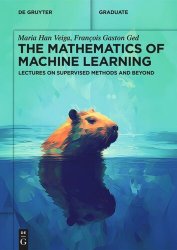The Mathematics of Machine Learning: Lectures on Supervised Methods and Beyond
- Добавил: literator
- Дата: 11-05-2024, 17:32
- Комментариев: 0
 Название: The Mathematics of Machine Learning: Lectures on Supervised Methods and Beyond
Название: The Mathematics of Machine Learning: Lectures on Supervised Methods and BeyondАвтор: Maria Han Veiga, François Gaston Ged
Издательство: De Gruyter
Год: 2024
Страниц: 210
Язык: английский
Формат: pdf (true), epub
Размер: 29.0 MB
This book is an introduction to Machine Learning, with a strong focus on the mathematics behind the standard algorithms and techniques in the field, aimed at senior undergraduates and early graduate students of Mathematics.
There is a focus on well-known Supervised Machine Learning algorithms, detailing the existing theory to provide some theoretical guarantees, featuring intuitive proofs and exposition of the material in a concise and precise manner. A broad set of topics is covered, giving an overview of the field. A summary of the topics covered is: statistical learning theory, approximation theory, linear models, kernel methods, Gaussian processes, deep neural networks, ensemble methods and unsupervised learning techniques, such as clustering and dimensionality reduction.
Machine Learning aims at building algorithms that autonomously learn how to perform a task from examples. This definition is rather vague on purpose, but to make it slightly clearer, by “autonomously” we mean that no expert is teaching (or coding by hand) the solution; by “learn” we mean that we have a measure of performance of the algorithm output on the task. In this chapter, we wish to give a general and accessible picture of machine learning through a mathematical formalism. We will introduce the notation, setup, and essential concepts of the field without dwelling on details. The current chapter should provide enough formalism and intuition to make the forthcoming chapters appear natural to the reader.
There are three main paradigms in Machine Learning, which sometimes share similar ideas while having very specific techniques. Namely,
• Supervised learning – we have access to labeled examples. For example, the task of spam detection using a dataset of emails, some of which we know are spam, and the others we know are not spam.
• Unsupervised learning – examples are not labeled. For example, the dataset is composed of paintings, and the algorithm must group them by guessing which come from the same artist or share the same style.
• Reinforcement learning – examples are generated from interacting with the environment. For example, the algorithm controls a drone and learns how to navigate the world by trial and error.
We note that these different types of learning are not mutually exclusive. In this book, we mostly focus on supervised learning; many aspects of our treatment can be transferred to unsupervised learning (Chapter 10) and reinforcement learning (Chapter 11).
This book is suited for students who are interested in entering the field, by preparing them to master the standard tools in Machine Learning. The reader will be equipped to understand the main theoretical questions of the current research and to engage with the field.
Скачать The Mathematics of Machine Learning: Lectures on Supervised Methods and Beyond
Внимание
Уважаемый посетитель, Вы зашли на сайт как незарегистрированный пользователь.
Мы рекомендуем Вам зарегистрироваться либо войти на сайт под своим именем.
Уважаемый посетитель, Вы зашли на сайт как незарегистрированный пользователь.
Мы рекомендуем Вам зарегистрироваться либо войти на сайт под своим именем.
Информация
Посетители, находящиеся в группе Гости, не могут оставлять комментарии к данной публикации.
Посетители, находящиеся в группе Гости, не могут оставлять комментарии к данной публикации.
